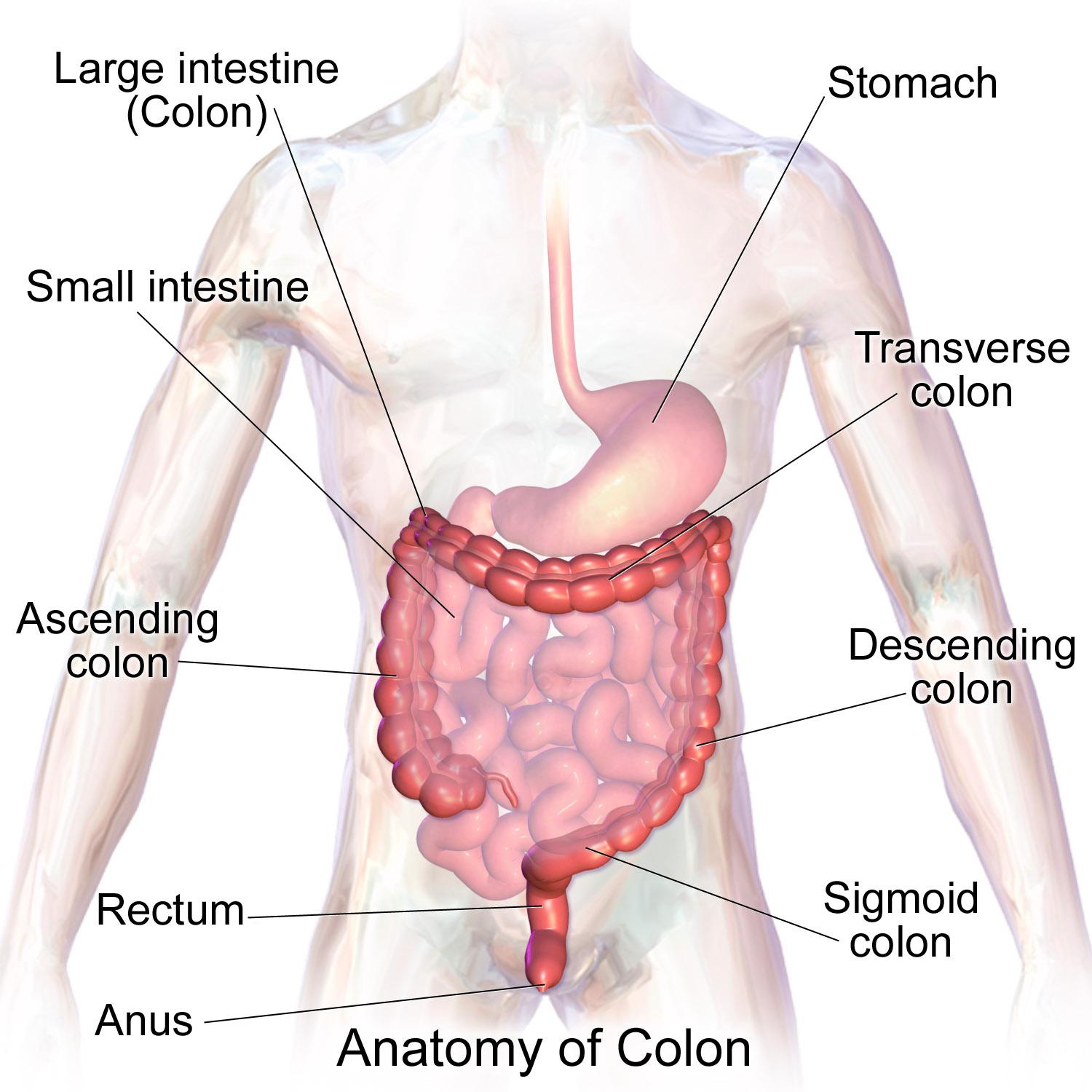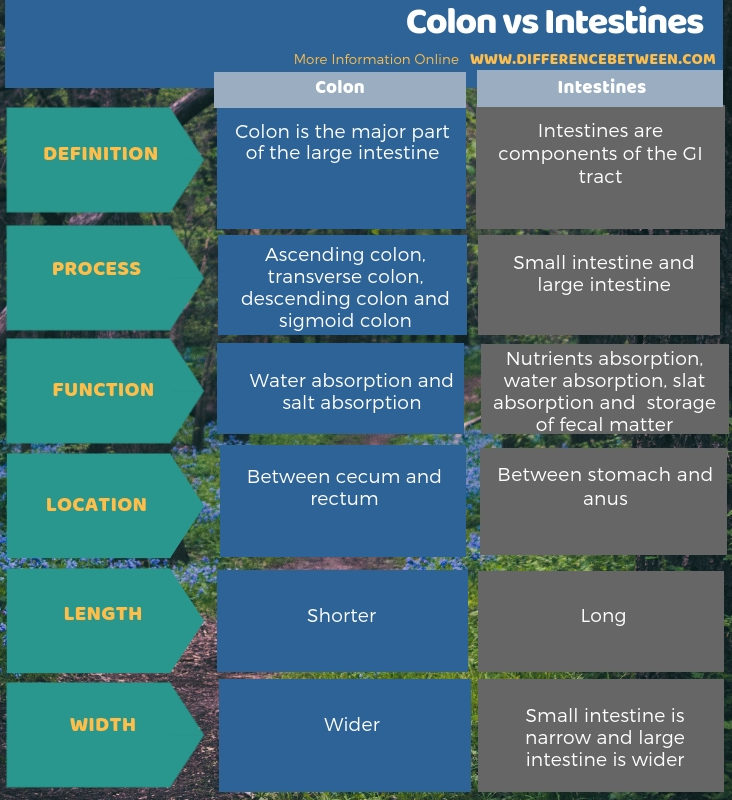Difference Between Colon and Intestines
The key difference between colon and intestines is that colon is a major section of the large intestine that consists of four parts as ascending colon, transverse colon, descending colon and sigmoid colon while the intestines constitute a significant part of the gastrointestinal tract and consist of the small intestine and large intestine.
Gastro-intestinal tract is one of the major organ systems present in our body. It consists of different components: mouth, pharynx, esophagus, stomach, intestines, and anus. Intestines start from the lower part of the stomach and extend up to the anus. Moreover, there are two types of intestines. They are the small intestine and large intestine. The small intestine is narrow and long while large intestine is wider and short. However, both intestines have different sections. In the large intestine, colon is the major part. Moreover, it is the principal site of water reabsorption.
CONTENTS
1. Overview and Key Difference
2. What is Colon
3. What are Intestines
4. Similarities Between Colon and Intestines
5. Side by Side Comparison – Colon vs Intestines in Tabular Form
6. Summary
What is Colon?
Colon is the main part of the large intestine and is 1.8 m long. The large intestine is one of the two components of the intestines of the GI tract. Colon mainly carries out water reabsorption. Furthermore, it employs salt absorption whenever necessary.

Figure 01: Colon
Structurally, the colon has four major parts as ascending colon, transverse colon, descending colon and sigmoid colon. The first part of the colon is the ascending colon, and it connects to the cecum. Whereas, sigmoid colon is the last part of the colon, and it connects to the rectum.
What are Intestines?
Intestines are muscular tubes and there are two types of intestines as the small intestine and large intestine. They are the two main parts of the GI tract. The small intestine is mainly responsible for nutrient absorption while large intestine is responsible for water absorption. Furthermore, the large intestine is responsible for storing faecal matter till defecation.

Figure 02: Intestines
Small intestine consists of three segments: duodenum, jejunum and ileum. Large intestine, on the other hand, consists of three main parts as cecum, colon and rectum. The inner lining of the small intestine has finger-like projections called villi, which have a higher surface area. Moreover, they absorb nutrients efficiently via diffusion. Furthermore, large intestine maintains wave-like movements to push contents in the intestines towards the anus.
What are the Similarities Between Colon and Intestines?
- Colon and intestines are parts of the gastrointestinal tract.
- Both parts are designed to absorb nutrients and water from the contents of the GI tract.
- Besides, both are muscular tube-like structures.
What is the Difference Between Colon and Intestines?
Colon is the major section of large intestine. But, intestines are major components of the alimentary canal of vertebrates. Therefore, we can consider this as the key difference between colon and intestines. Furthermore, the colon has four segments as ascending colon, transverse colon, descending colon and sigmoid colon while intestines are two types as the small intestine and large intestine.
Moreover, colon facilitates water reabsorption while intestines facilitate nutrients absorption, water absorption and salt absorption. Functionally, this is the difference between colon and intestines. Besides these differences, based on location too, we can identify a difference between colon and intestines. That is; the colon is between cecum and rectum while intestines are between stomach and anus. Also, the size of them is a further difference between colon and intestines. The colon is wider and shorter, but the small intestine is narrow and long. However, the large intestine is wider and shorter.
Below illustration summarizes the difference between colon and intestines.

Summary – Colon vs Intestines
Intestines are components of the alimentary canal of the vertebrates. There are two types of intestines as the small intestine and large intestine. The small intestine is long and narrow, and it facilitates nutrient absorption while large intestine is wider and shorter and it facilitates water absorption and storage of faecal matter till defecation. The large intestine has three segments. Among them, the colon is the major part that consists of four segments. Moreover, it is the principal site of water reabsorption. Thus, this is a summary of the difference between colon and intestines.
Reference:
1. “How Does the Intestine Work?” Current Neurology and Neuroscience Reports., U.S. National Library of Medicine, 17 May 2018, Available here.
2. “Large Intestine.” Wikipedia, Wikimedia Foundation, 11 Feb. 2019, Available here.
Image Courtesy:
1. “Blausen 0603 Large Intestine Anatomy” By Blausen.com staff (2014). “Medical gallery of Blausen Medical 2014”. WikiJournal of Medicine 1 (2). DOI:10.15347/wjm/2014.010. ISSN 2002-4436. – Own work (CC BY 3.0) via Commons Wikimedia
2. “Illu intestine” (Public Domain) via Commons Wikimedia
ncG1vNJzZmivp6x7pbXFn5yrnZ6YsqOx07CcnqZemLyue8OinZ%2Bdopq7pLGMm5ytr5Wau26vzqWmp2WRo7Futc2tnKysmaOytHs%3D